Interested in the 1940 Wheat Penny value? You’re in the right place!
In this guide, we’ll explore how a 1940 penny’s color and condition affect its value. We’ll also take a look at some fascinating error coins, and learn about the history and design of these classic cents along the way.
Ready to dive in? Let’s get started!
1940 Wheat Penny Value Chart
Values for business strike coins below are for red (RD) examples.
| Mint Mark | MS62 | MS65 | MS67 | MS68 |
|---|---|---|---|---|
| 1940 (P) No Mint Mark | $4 | $24 | $200 | $9,000 |
| 1940 D | $5 | $28 | $160 | $10,000 |
| 1940 S | $6 | $24 | $175 | $11,000 |
1940 (P) Proof Wheat Penny Value
| Grade | Brown | Red & Brown | Red | Cameo |
|---|---|---|---|---|
| PR60 | $22 | $25 | $30 | $100 |
| PR63 | $37 | $65 | $80 | $475 |
| PR65 | $70 | $100 | $150 | $2,750 |
| PR67 | – | – | $4,850 | – |
History of the 1940 Wheat Penny
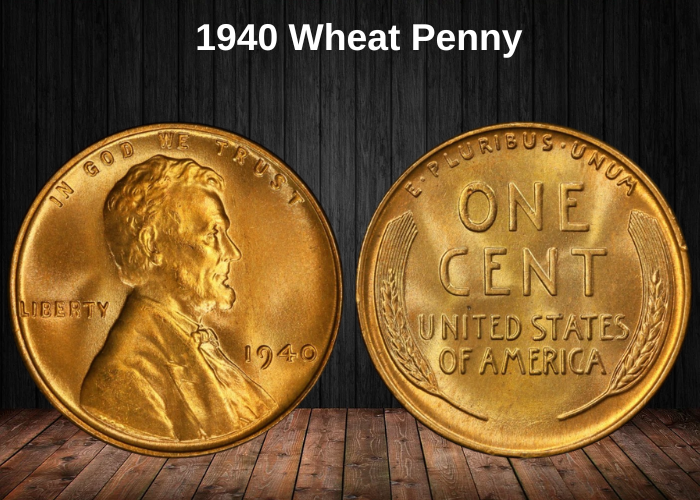
The name “Wheat penny” comes from the design on the reverse (or “tails” side) of the coin. It features two stylized ears of wheat, curving symmetrically up each side of the coin.
This was the original design used for what are commonly known as Lincoln cents or Lincoln pennies, which were first struck in 1909. And that year was historic for two reasons.
First, 1909 marked the 100th anniversary of President Abraham Lincoln’s birth, a major milestone that sparked widespread admiration for the late president, who had been assassinated in 1865.
Second, it was the first time a real person had ever appeared on a U.S. coin. Before then, U.S. coinage typically featured allegorical figures like Lady Liberty rather than historical figures.
The idea of honoring Lincoln with a coin was considered a fitting tribute. And the same portrait of Lincoln that appeared on the original Wheat pennies is still used on the penny today. However, the reverse design has changed multiple times.
- In 1959, 50 years after the Wheat penny was introduced, the reverse was redesigned to feature the Lincoln Memorial in Washington, D.C.
- Then in 2010, it was updated again to show the Union Shield, which remains in use on today’s one-cent coins.
Both the portrait of Lincoln and the original wheat ears were the work of Victor David Brenner, a Latvian-born artist. Born in Šiauliai (then part of the Russian Empire), Brenner came from a family of metalworkers. He was trained in artistic metalwork from an early age and eventually emigrated to the U.S. in 1880.
In America, he worked as a die cutter and engraver, later refining his skills with artistic training in Paris. He returned to New York in 1906, and in 1909, his design for the Lincoln cent was approved.
Interestingly, Brenner’s first design for the reverse was a tree branch, but this was rejected for looking too much like contemporary French coinage. His second design, featuring wheat ears, was accepted.
Brenner initially wanted to sign Lincoln’s portrait, but that idea was rejected. Instead, he discreetly placed his initials “V.D.B.” on the reverse of the coin. However, even those were deemed too prominent and were removed shortly after the coin’s release. They were finally reinstated in 1918, this time subtly engraved on the cut-off at the bottom of Lincoln’s shoulder.
The 1940 Wheat pennies were composed of 95% copper and 5% tin and zinc, the same bronze alloy used for the original 1909 cents. However, this would soon change. When the United States entered World War II, copper and tin became vital for the war effort. As a result, production of bronze cents was scaled back in 1942 and halted entirely in 1943. For that year, pennies were struck using zinc-coated steel instead.
Features of the 1940 Wheat Penny
The obverse of the 1940 Wheat penny
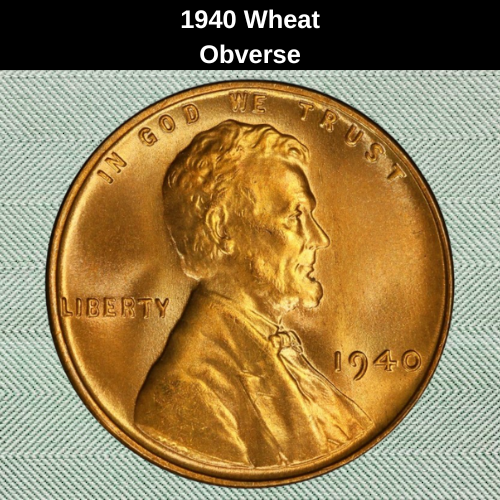
The obverse of the 1940 Wheat penny features the same image of President Abraham Lincoln that has appeared on U.S. cents for over a century. It shows Lincoln in right-facing profile, depicted from the shoulders up.
Above his head is the national motto, “IN GOD WE TRUST,” curving along the top edge of the coin. To the left of his portrait is the word “LIBERTY,” while the date appears on the right. If the coin was struck at the Denver or San Francisco Mint, a small “D” or “S” mint mark will appear just below the date.
The reverse of the 1940 Wheat penny
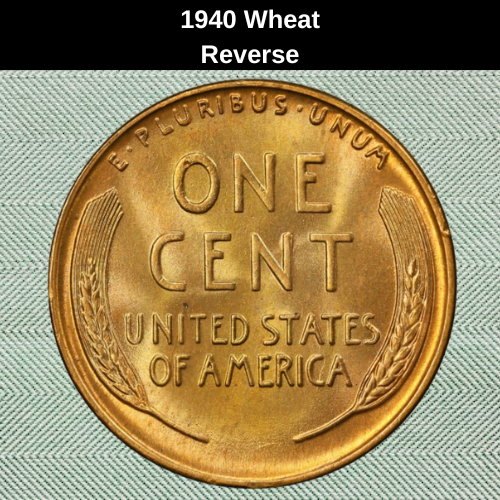
The reverse of the 1940 Wheat penny features a clean and simple design. At its center, the denomination is boldly displayed in full capital letters across two lines: “ONE CENT”. Just beneath it, also in capitals but in a smaller font, is the country name: “UNITED STATES OF AMERICA.”
At the top of the coin, the Latin motto “E PLURIBUS UNUM” curves along the upper rim. It means “Out of many, one,” a reference to the unity of the American states.
The design is framed by two stylized ears of durum wheat, one curving along each side of the coin. These wheat stalks give the coin its popular nickname — the Wheat penny.
Other features of the 1940 Wheat penny
The 1940 penny is made of bronze – an alloy consisting of 95% copper, with the remaining 5% a mixture of tin and zinc. It weighs 3.11 grams and measures 19 millimeters in diameter.
Because of its high copper content, individual coins show considerable variation in color. They’re classified into one of three color categories: red (RD), red and brown (RB), or brown (BN).
When freshly minted, copper coins have a bright red luster. Over time, exposure to air and handling causes the surface to oxidize and turn brown. Coins that have retained their original red color are especially prized by collectors.
To be officially graded as red, a coin must show red coloration across at least 95% of its surface. If 95% or more is brown, it’s classified as brown. Anything in between is categorized as red and brown.
1940 Wheat Penny Grading
| # | Grade |
|---|---|
| 1 | Basal State-1 |
| 2 | Fair |
| 3 | Very Fair |
| 4, 5, 6 | Good |
| 7, 8, 10 | Very Good |
| 12, 15 | Fine |
| 20, 30 | Very Fine |
| 40 | Extremely Fine |
| 50 | About Uncirculated |
| 60 | Mint State |
| 65 | Mint State |
| 70 | Mint State |
1940 Wheat Penny Value Guides
1940 No Mint Mark Wheat Penny Value
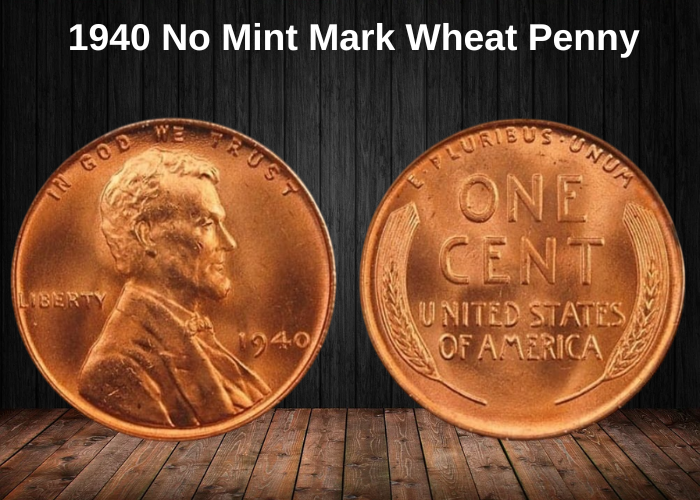
To determine if your penny was struck in Philadelphia, check the obverse (front) of the coin. If there’s no small “D” (Denver) or “S” (San Francisco) beneath the date, then your coin came from Philadelphia.
That alone doesn’t make it rare—almost 587 million pennies were minted in Philadelphia in 1940. According to PCGS (Professional Coin Grading Service), around 12,000 examples still exist today in collectible condition.
About half of those are “gem quality” coins, meaning they’re graded MS65 or higher on the 1–70 coin grading scale. These are the most desirable and valuable examples among collectors.
Because of the high number of surviving coins, most 1940 Philadelphia Wheat pennies are not especially valuable—especially those graded brown or red and brown. In most cases, these won’t be worth more than face value.
However, red coins in mint state (MS) condition do hold some value. A red MS62 penny is worth about $4, and a gem-quality MS65 example sells for around $24.
The highest-grade coins are significantly more valuable. At MS67, a red 1940 Philadelphia penny is valued at $200. The very best known examples, graded MS68, have only nine known survivors, and PCGS values each of those at $9,000.
1940 D Wheat Penny Value
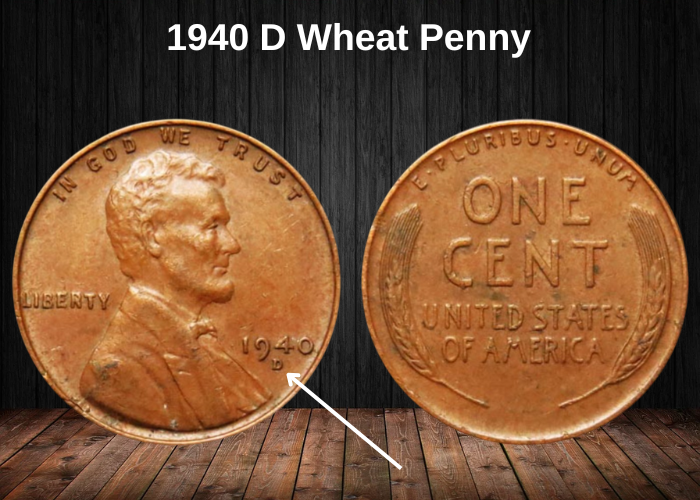
A “D” beneath the date on the obverse of your 1940 Wheat penny indicates it was struck at the Denver Mint.
Although far fewer pennies were minted in Denver that year—about 81 million, compared to Philadelphia’s 587 million—they’ve actually survived in greater numbers. According to PCGS, around 18,000 examples remain today, with half of those graded MS65 or higher.
In most grades, their values are similar to Philadelphia coins. Unless it has a Mint error, a brown or red and brown coin will typically be worth only face value.
Red coins in mint state hold more value. A red MS62 example is worth around $5, rising to $28 at MS65, and $160 at MS67. PCGS has certified 59 coins at MS67+, and each is valued at approximately $725.
As with Philadelphia issues, the highest known grade is MS68. Only eight red 1940 Denver pennies have been certified at that level, and PCGS values them at $10,000 each.
1940 S Wheat Penny Value
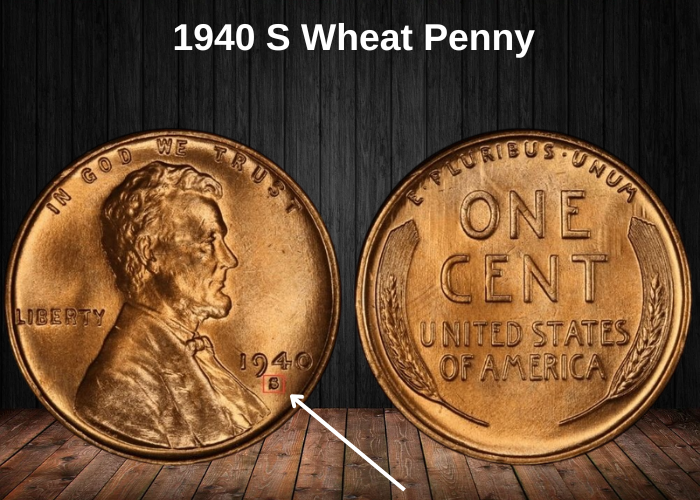
The San Francisco Mint struck nearly 113 million pennies in 1940. These can be identified by the small “S” mint mark beneath the date on the obverse.
According to PCGS, there are likely more surviving examples from San Francisco than from Philadelphia, but fewer than Denver. It’s estimated that around 18,000 coins still exist, with about half graded MS65 or higher.
Values are generally in line with coins from the other Mint facilities. A red 1940-S Wheat penny graded MS62 is valued at $6, rising to $24 at MS65, and $175 at MS67.
At the top end, the most valuable examples are red coins graded MS68. So far, eight have been certified, each valued at $12,000.
1940 (P) Proof Wheat Penny Value
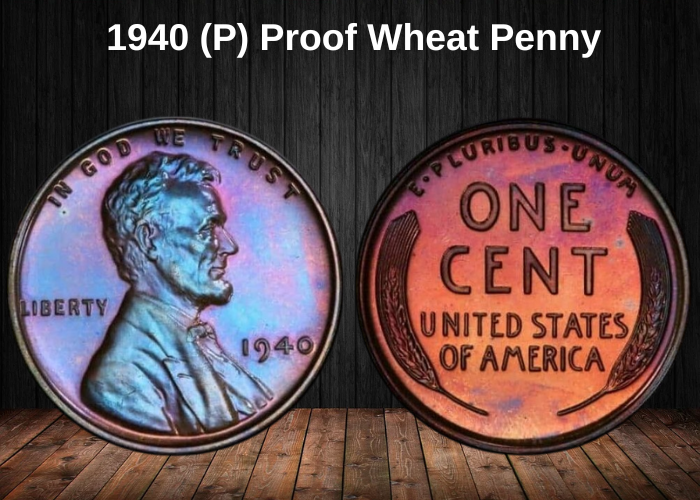
The Philadelphia Mint struck both regular pennies and proofs in 1940, with the latter specifically targeted at collectors. These proof coins were made using special planchets and dies.
Today, they are classified into four different levels. In addition to the three standard color varieties for copper coins (red, red and brown, brown), some proof coins are designated as “cameos”. These feature an appealing contrast between the reflective flat areas and frosted raised parts of the design.
Proof Wheat pennies range in value from $25 for a red and brown coin graded MS60 to $15,000 for a red coin graded MS67+.
The finest cameo to have surfaced so far is graded 1.5 points lower at MS66. PCGS values this coin at $6,500.
Rare 1940 Wheat Penny Error List
1940 S Wheat Penny, Repunched Mint Mark
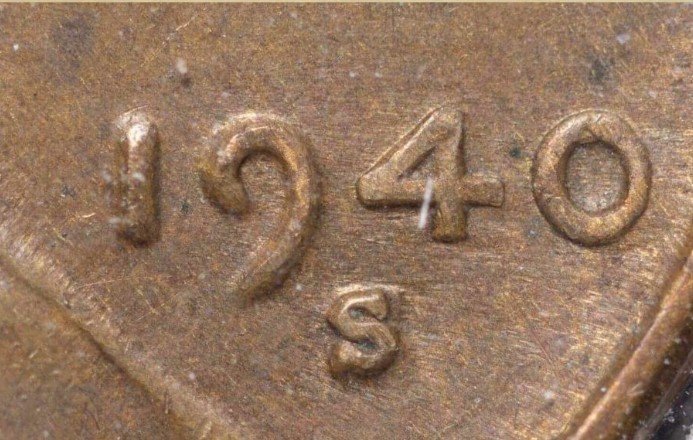
Sometimes, coins can have their mint mark punched a second or even third time. This type of error occurred with some of the Wheat pennies struck at both the San Francisco and Denver mints in 1940.
These errors are most easily detected with the aid of a microscope or loupe. Repunched mint marks, commonly abbreviated as RPM in coin descriptions, are identified by the relative positions of the first and later mint marks.
As with coins without errors, the better condition of the coin results in a higher value.
For example, one San Francisco coin had the S mint mark repunched twice (coded RPM-7 by the coin graders ANACS). This coin was graded MS64 red and sold at auction for $70.
1940 S Wheat Penny, Double Die Obverse
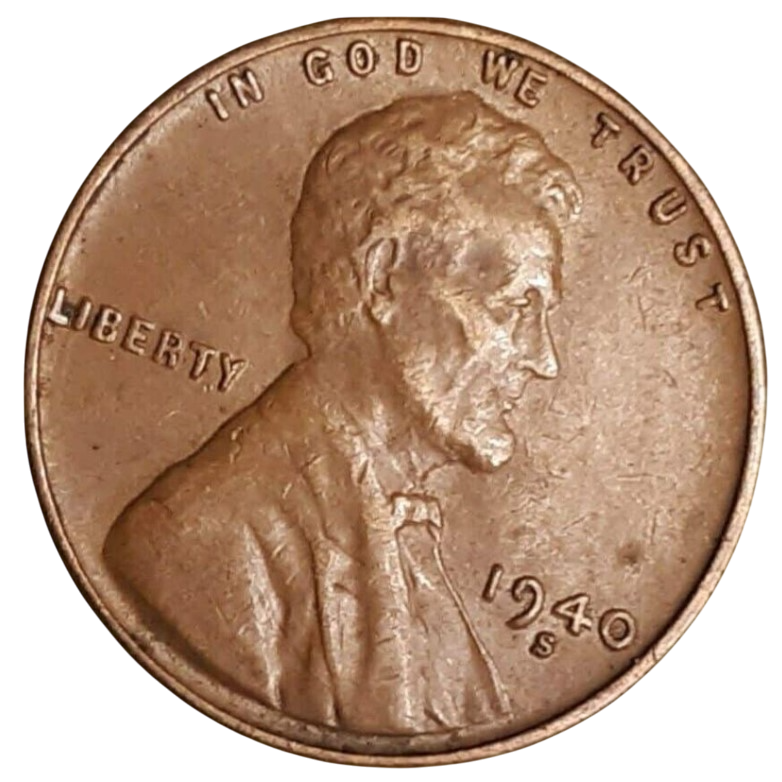
Another type of error that affected some of the 1940 San Francisco Wheat pennies is the double die obverse.
A double die error happens when there’s a problem during the production of the die used to strike the coins. The hub strikes the die more than once to capture the design, and if there’s any movement between strikes, it leaves behind a double image.
This doubling is then transferred to any coins struck by the defective die. If the error occurs on the obverse die, it’s referred to as a double die obverse. If it’s on the reverse die, it’s known as a double die reverse.
One such 1940 San Francisco penny with a double die obverse was certified by the independent coin graders ANACS. It was a red coin, graded MS67—making it valuable even without the error. This coin sold at auction for $175.
Where to sell your penny?
Now that you know the value of your penny, you might be wondering where to sell it. Don’t worry: here’s a guide to some of the best online platforms where you can easily sell your coins, along with their advantages and disadvantages.
Discover the best platforms for selling coins online (pros and cons).
FAQs
1. How does the 1940 Wheat Penny reflect the economic conditions of the United States on the brink of World War II?
The 1940 Wheat Penny was minted during a time when the United States was recovering from the Great Depression, but tensions were rising globally with the approach of World War II. In 1940, the U.S. economy was in a period of recovery, and the country had yet to fully mobilize for war. This penny, like others from the late 1930s and early 1940s, served as a representation of pre-war economy, with many Americans still recovering from the financial hardship of the 1930s. The penny’s composition (95% copper and 5% tin and zinc) remained unchanged before wartime materials began to be redirected for military use in the early 1940s, marking a transitional moment in U.S. coinage history.
2. What factors make the 1940 Wheat Penny one of the more commonly found pennies in circulation today, despite its large mintage?
The 1940 Wheat Penny has a very high mintage, especially from the Philadelphia Mint where 887 million were produced. This immense production number means that a large portion of these coins were circulated widely, and as a result, they are relatively easy to find in lower grades today. Despite this, high-grade examples in uncirculated condition (such as MS65 or higher) are much harder to come by, making them desirable for collectors. Its widespread circulation ensures that it remains a common coin, but well-preserved examples are still prized for their rarity in top condition.
3. How does the mint mark of the 1940 Wheat Penny influence its value and rarity, especially for the 1940-D and 1940-S?
The mint mark plays a key role in the rarity and value of the 1940 Wheat Penny. While the Philadelphia mint produced over 887 million coins, the 1940-D (Denver) had only 20 million minted and the 1940-S (San Francisco) had 40 million minted, making them relatively scarcer than the Philadelphia version. However, it’s important to note that even though the 1940-D and 1940-S are less common, the real increase in value happens when coins are found in higher grades, particularly in uncirculated conditions. The 1940-D is more sought after than the 1940-S due to its lower mintage, but both are more valuable than the Philadelphia version in higher grades.
4. Why is the 1940 Wheat Penny considered a crucial piece for a complete Wheat Cent collection, especially when it comes to mint variety and quality?
The 1940 Wheat Penny is important for completing a Wheat Cent collection because it marks the last years of the Wheat Cent design before the transition to the Lincoln Memorial design in 1959. It is an integral part of understanding the progression of U.S. coinage, specifically in the late 1930s and early 1940s when the country was in a transition from the Great Depression to World War II. Collectors pay particular attention to obtaining high-quality examples of this coin, especially from the San Francisco and Denver mints, as they are more challenging to find in high grades, making them a must-have for serious collectors.
5. What role do die variety errors (like re-punched mint marks or die cracks) play in the value of a 1940 Wheat Penny?
Although the 1940 Wheat Penny is generally considered a common coin, collectors seek out varieties and errors that make specific coins more valuable. Some notable types of errors include:
- Re-punched mint marks (RPMs), especially on the 1940-D and 1940-S coins, where the mint mark was struck more than once.
- Die cracks and cuds, which occur when imperfections form on the die during the minting process and result in errors on the coin.
- Off-center strikes and broadstrikes, which make for unique and desirable error coins.
These types of errors, when found in higher grades, can significantly increase the coin’s market value as they appeal to error coin enthusiasts and those looking for more unusual and distinctive pieces for their collection.
6. How do the physical characteristics and composition of the 1940 Wheat Penny contribute to its longevity and condition in the modern numismatic market?
The 1940 Wheat Penny is made from 95% copper and 5% tin and zinc, a composition that gives the coin a distinctive reddish-brown hue. Copper coins from this era tend to oxidize over time, often resulting in toning and patina. Despite being heavily circulated, the copper material gives the 1940 penny a degree of longevity, as many coins from this era have remained in existence due to the relative durability of copper. However, as the penny ages, signs of wear, especially on the high points of Lincoln’s portrait and the wheat stalks, are common. Collectors seek out well-preserved examples where these features remain sharp, often seeking out those with minimal toning and luster loss.
7. How does the 1940 Wheat Penny compare to other years in terms of value growth over time, especially in terms of high-grade examples?
While the 1940 Wheat Penny is not as rare or valuable as some earlier issues (like the 1909-S VDB or 1914-D), it still holds significant long-term value potential in high-grade examples, especially in MS65 RD or higher. As time progresses, collectors continue to appreciate well-preserved examples that represent a key moment in U.S. coinage. The penny has seen a steady increase in value, particularly for high-grade coins, because quality examples of more common years tend to become scarcer over time. The future potential for growth in value is there, especially for those mint marks with lower mintage numbers and sharp details.



















































